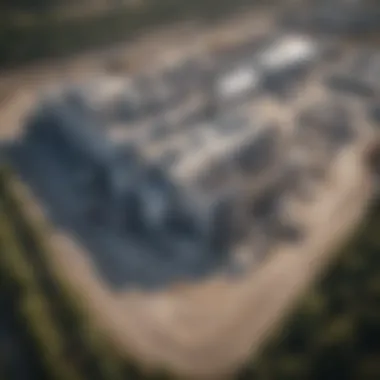Concrete Sustainability: The Future of Building Materials


Intro
The construction industry relies heavily on concrete, yet its production is associated with significant environmental concerns. As the world faces the pressing challenges of climate change, understanding concrete's sustainability becomes crucial. This article will dissect the ecological ramifications of concrete's life cycle, spotlighting innovations, sustainable practices, and alternatives that might redefine material usage in construction.
Emerging research underlines the need for sustainable construction materials, which can mitigate negative environmental impact while ensuring structural integrity. By evaluating current methodologies and future technologies, we aim to navigate the complexities of concrete sustainability.
Research Overview
The exploration of concrete sustainability involves both extensive research and ongoing discussions within the scientific community. Understanding how concrete's production can be optimized to limit ecological damage is paramount.
Summary of Key Findings
- Carbon Footprint: Concrete production contributes approximately 8% of global CO2 emissions. Emphasis on encapsulating carbon during mixing presents a reduction strategy.
- Recycling Practices: Utilization of recycled aggregate can decrease the demand for virgin materials, thus lowering environmental degradation.
- Alternative Materials: Incorporating materials like fly ash or slag can enhance performance while reducing reliance on limestone, the primary component of traditional concrete.
- Technological Innovations: Advances such as carbon capture storage and utilization, alternative binding materials, and improved mixing processes could address some of the critiques facing conventional concrete.
Relevance to Current Scientific Discussions
The conversation surrounding concrete sustainability is gaining momentum. Scholarly articles focus on the need for more holistic approaches to construction, pushing for interdisciplinary strategies that marry engineering with environmental science. Professional forums and discussions, such as those found on platforms like reddit.com and facebook.com, emphasize the need for collaboration across sectors to innovate in concrete technology.
Methodology
An in-depth analysis of concrete sustainability involves various research methods that provide a foundation for conclusions drawn in this article.
Research Design and Approach
This article utilizes both qualitative and quantitative methods to provide a comprehensive overview. Observations from industry practices blend seamlessly with statistical analyses that highlight trends and outcomes in sustainable concrete production.
Data Collection and Analysis Techniques
- Case Studies: Detailed examinations of projects utilizing innovative concrete alternatives provide real-world evidence of sustainability.
- Surveys: Gathering insights from professionals in the construction industry helps illuminate how practices are evolving.
- Literature Review: A systematic review of existing academic research forms the core basis for understanding the implications of concrete's ecological footprint.
Intro to Concrete Sustainability
Concrete is the most widely used construction material in the world. Its applications span residential buildings, roads, bridges, and industrial structures. Yet, its production is a significant contributor to environmental degradation. Understanding concrete sustainability is vital as it involves not only improving the material itself but also addressing the broader impacts of its production and use.
The need for sustainable concrete practices arises from the pressing environmental challenges faced globally. This section aims to highlight various aspects of concrete sustainability. By exploring its definition and the importance of implementing sustainable practices, we seek to lay a foundational understanding.
Definition of Sustainability in Concrete
Sustainability in the context of concrete involves creating methods and processes that minimize environmental harm while optimizing resource use. It encompasses several key factors:
- Resource Efficiency: Using raw materials more efficiently limits waste.
- Environmental Protection: Reducing pollution and emissions associated with concrete production.
- Longevity and Reusability: Designing concrete that lasts longer and can be reused or recycled.
- Economic Viability: Ensuring that sustainable practices are also cost-effective for producers.
In essence, sustainable concrete not only meets current infrastructure demands but does so in a way that preserves environmental quality for future generations.
Importance of Sustainable Practices in Construction
The construction industry faces increasing scrutiny over its environmental footprint. Implementing sustainable practices in concrete production presents various advantages:
- Reduction of Environmental Impact: Sustainable concrete can significantly lower energy consumption and emissions associated with traditional methods.
- Compliance with Regulations: New government regulations often mandate lower emissions and reduced resource extraction. Sustainable concrete practices help companies adhere to these standards.
- Market Demand: There is a growing demand from consumers and stakeholders for green construction solutions. Sustainable practices can enhance a company's reputation and marketability.
- Resource Resilience: As resources dwindle, sustainable practices promote the careful management and reuse of materials, ensuring a stable supply for the future.
"Sustainable construction is not just a trend; it's a necessity for lasting infrastructure that respects both people and the planet."
Environmental Impact of Traditional Concrete Production
The process of concrete production has long been scrutinized for its environmental implications. Understanding the environmental impact of traditional concrete production is essential in formulating sustainable alternatives. This section explores various facets of concrete production, including resource extraction, energy consumption, and greenhouse gas emissions. By delving into these aspects, we can highlight the necessity for sustainable practices in an ever-evolving construction industry.


Resource Extraction and Depletion
The first concern in the environmental impact of traditional concrete is the extraction of raw materials. Concrete primarily comprises cement, water, sand, and aggregate. The extraction of these materials, notably sand and gravel, can lead to significant ecological degradation. Riverbeds and quarries become disturbed ecosystems, often affecting local flora and fauna. According to estimates, sand extraction has increased dramatically, resulting in depletion of resources in some areas.
Moreover, this extraction process often involves large-scale mining operations, which can lead to soil erosion, habitat destruction, and water quality issues. The environmental consequences extend beyond immediate damage. They also pose significant long-term effects on the landscape and biodiversity.
Energy Consumption in Manufacturing
The energy required to manufacture concrete is substantial. The process of producing cement, a critical component of concrete, is particularly energy-intensive. It involves heating limestone and clay to high temperatures, which results in significant energy consumption. The reliance on fossil fuels for this process contributes to a larger carbon footprint.
A significant reduction in energy use can be achieved through innovation in manufacturing. Incorporating renewable energy sources, such as wind or solar, can help alleviate some of these environmental concerns. However, the current systems in place often remain rooted in traditional energy sources, hindering progress toward sustainability.
Greenhouse Gas Emissions
Concrete production is responsible for approximately eight percent of global greenhouse gas emissions. Most of these emissions result from the chemical reactions involved in cement production and the combustion of fossil fuels. Carbon dioxide is a primary byproduct of these processes, contributing to climate change.
Efforts are underway to mitigate these emissions through various strategies. For instance, the incorporation of supplementary cementitious materials can replace a portion of traditional cement, lowering emissions while maintaining performance standards. Furthermore, developing new cement formulations that decrease the carbon output could provide viable pathways toward a greener industry.
In addressing climate change, the construction sector must prioritize sustainable practices in concrete production.
Innovations in Sustainable Concrete Production
Innovations in sustainable concrete production represent a pivotal shift in the construction industry. These advancements address the urgent need to mitigate environmental impacts associated with traditional concrete manufacturing. Incorporating novel methods not only helps in reducing the carbon footprint but also enhances the overall performance and durability of the material. As eco-conscious building practices gain prominence, it becomes clear that the future of concrete lies in innovation.
Recycling and Reuse of Concrete
Recycling of concrete has emerged as a crucial practice for reducing waste and promoting sustainability. The process involves crushing old concrete structures and reusing the aggregate in new concrete mixes. This method significantly decreases the need for virgin materials and minimizes construction debris. The environmental benefits are evident, as it lowers landfill usage and reduces the extraction of natural resources.
Moreover, the recyclability of concrete allows for a closed-loop system where materials can be reused multiple times. This not only plays a vital role in sustainability but also offers economic advantages. With reduced material costs and the potential for new markets in recycled aggregates, construction companies can enhance profitability while adhering to green building standards.
Use of Alternative Materials
The quest for more sustainable concrete has led to the exploration of alternative materials. Substituting traditional cement with industrial by-products like fly ash, slag, or silica fume is one way to lower emissions. Such replacements can improve the concrete's performance, enhancing both strength and durability.
In addition, the incorporation of biobased materials, such as hemp or agricultural waste, is gaining traction. These materials not only provide an eco-friendly alternative but also help in carbon sequestration. Utilizing such alternatives not only meets the environmental goals but also presents opportunities for innovation in formulation and application. The increasing availability of these materials is promising for the industry's journey toward sustainability.
Low-Carbon Technologies in Production
Implementing low-carbon technologies in concrete production is essential for meeting climate targets. Innovations such as carbon capture, utilization, and storage (CCUS) are leading the way. This technology captures carbon dioxide emissions generated during the manufacturing process, storing it for further use or safely disposing it.
Furthermore, advancements in production techniques, like optimizing kiln temperatures and using renewable energy sources, contribute to reduced energy consumption. For instance, utilizing solar energy in the curing process demonstrates how aligning traditional practices with renewable options can achieve sustainability goals.
These low-carbon approaches collectively reduce greenhouse gas emissions and elevate the profile of concrete as a material capable of supporting sustainable development. As the industry transitions, embracing these technologies will be critical in achieving long-term environmental viability and addressing the generational demands for greener infrastructure.
Performance Metrics of Sustainable Concrete
The evaluation of sustainable concrete involves assessing its performance metrics. This is crucial in determining how well these materials can perform in comparison to traditional options. Concrete must provide adequate strength and durability while also maintaining low environmental impact. Key areas to explore include the material's strength, its durability over time, and its overall lifespan, alongside maintenance requirements.
Strength and Durability Comparisons
Strength is a fundamental characteristic of concrete. In sustainable concrete production, achieving competitive strength levels is vital. Technologies such as incorporating recycled aggregates, fly ash, or slag can enhance strength without harming the environment. Studies indicate that when designed properly, sustainable concrete can match or exceed the performance of its conventional counterparts.
Durability goes hand in hand with strength. Factors like permeability, resistance to weathering, and chemical exposure are critical. High-performance sustainable concrete can resist cracking and deterioration, extending its usability. This is especially advantageous in infrastructure projects, reducing the need for frequent repairs and minimizing resource use.
Some advantages of sustainable concrete in strength and durability include:
- Resistance to extreme weather conditions
- Lower maintenance costs over time
- Reduced environmental impact from fewer replacements


Lifespan and Maintenance Considerations
The lifespan of sustainable concrete plays a significant role in its overall effectiveness. A longer lifespan translates to fewer resources required for repairs and replacements. With increased demand for lasting infrastructure, developing concrete that performs well over decades is paramount. Sustainable practices often utilize advanced materials and engineering techniques that contribute to prolonged durability.
Maintenance is another critical area to assess. Sustainable concrete should require less maintenance than traditional concrete. This not only saves costs but also reduces the labor and materials involved in upkeep. Eco-friendly solutions often provide features that minimize maintenance needs. For instance, surface treatments that resist staining and moisture penetration enhance lifespan without adding environmental burden.
In evaluating lifespan and maintenance of sustainable concrete, consider the following aspects:
- Regular inspections to prevent small issues from becoming large problems
- The influence of environmental conditions on performance
- Availability of sustainable sealants and treatments that enhance durability
"Sustainable concrete must not only perform well initially, but also provide a long-lasting solution that minimizes further environmental impact."
The comparison between traditional and sustainable options in these areas reveals a path forward for innovation in construction. By focusing on performance metrics, stakeholders can make informed decisions that align with both structural integrity and environmental sustainability.
Case Studies in Sustainable Concrete Usage
Examining real-world applications of sustainable concrete practices shows the effectiveness and viability of various techniques. This focus on case studies underscores the willingness of the construction industry to innovate, adapt, and improve environmental practices. Understanding these implementations provides valuable insights into the benefits and challenges encountered when moving toward more sustainable solutions in concrete production.
Successful Implementations Worldwide
Many countries have demonstrated success with sustainable concrete methods. Notable examples showcase innovative techniques, optimal material use, and positive environmental impacts. One such example is the use of recycled concrete aggregates in the construction of infrastructure in Holland. This approach not only reduced the need for virgin aggregates but also minimized waste from demolished structures.
In Singapore, a project utilized high-performance sustainable concrete that incorporates industrial by-products like fly ash and slag. This reduced the carbon footprint significantly compared to traditional concrete mix designs. The project was well-received, as it demonstrated the potential for urban construction to be both functional and sustainable.
Across the globe in São Paulo, Brazil, a major highway development project has integrated pavements made from rubberized concrete. By using recycled rubber from tires, the project not only provides durable infrastructure but also addresses a significant waste disposal issue.
These successful implementations do not just serve as isolated successes; they provide templates that other regions can follow, adapting their sustainable strategies based on local needs and resources.
Lessons Learned from Failures
However, sustainability practices in concrete construction are not without their challenges. Learning from past failures is crucial to moving forward effectively. One such failure occurred in California, where a high-profile project aimed to use a new low-carbon concrete mix. Unfortunately, inadequate quality control led to significant structural integrity issues, causing the project to be delayed and necessitating costly repairs.
Another example highlights complications in Germany, where an initiative to implement bio-based additives in concrete faced resistance. The lack of understanding about the materials’ performance and long-term durability created skepticism among contractors and legislators, ultimately leading to its slow adoption.
"The road to sustainability is paved with trials and errors, but each setback brings the industry closer to progress."
These cases illustrate the importance of thorough research, clear communication, and stakeholder education when implementing new sustainable practices. Successful sustainable concrete usage requires not only innovative materials and methods but also judicious planning and community engagement to ensure acceptance and efficacy.
Understanding both successful implementations and failures helps refine future approaches in sustainable concrete usage. It encourages the industry to be cautious yet optimistic, learning from the past while paving a greener path forward.
With each case study, the narrative around concrete sustainability continues to evolve, indicating that a balance between performance and environmental consciousness can and should be achieved.
Challenges in Adopting Sustainable Concrete Practices
The adoption of sustainable concrete practices presents numerous challenges that must be addressed for the future of construction materials. These challenges stem from a variety of factors that range from economic impacts to regulatory requirements. The recognition of these hurdles aids in understanding the obstacles that stakeholders face, while also providing insight into potential paths for overcoming them.
Economic Factors and Cost Analysis
Economic considerations are pivotal when it comes to the adoption of sustainable concrete. Transitioning from traditional methods to more sustainable practices often incurs significant initial costs. These expenses can arise from the need for advanced technologies, new materials, and even retraining the workforce. However, it is crucial to analyze these costs over the long term.
Many researchers argue that while the upfront investment may be higher, sustainable materials can lead to lower maintenance and operational costs. For example, concrete produced with recycled aggregates can be less expensive than traditional materials in the long run. Additionally, some studies show that the lifecycle costs of sustainable concrete are generally lower, as they tend to have prolonged durability.
Furthermore, policymakers play a key role in economic factors by providing subsidies or incentives that can alleviate initial expenses. Understanding where these supports can come from is critical for stakeholders aiming to innovate in sustainable concrete.
Regulatory and Compliance Barriers


Regulatory hurdles can significantly impede the advancement of sustainable concrete practices. Building codes often favor traditional materials and methods, making it difficult for innovative techniques to gain traction. Compliance with existing regulations can be time-consuming and expensive for companies trying to adopt sustainable methods.
Moreover, there is often a lack of clear guidelines regarding what qualifies as sustainable concrete. This ambiguity can cause confusion among builders and contractors.
To address these issues, there is a need for collaboration between various stakeholders, including governments, industry leaders, and researchers. Establishing standardized regulations for sustainable practices can pave the way for broader acceptance in the industry.
Knowledge Gaps in Industry
The construction industry is often steeped in tradition. This can create knowledge gaps that hinder the adoption of new practices. Many professionals may lack familiarity with sustainable materials and their benefits.
Training and education are essential to bridge this gap. Universities and organizations can play a crucial role in informing both current and future professionals about sustainable concrete options.
Moreover, there is often a disconnect between research findings and practical application. Researchers need to communicate their findings effectively, while industry professionals must be willing to engage with innovative methods. Addressing these knowledge gaps is vital for the successful integration of sustainable concrete practices in everyday construction.
Future Directions in Sustainable Concrete Research
As the construction industry grapples with the pressing need for sustainability, it becomes essential to explore future directions in sustainable concrete research. This area is not solely about improving material properties; it encompasses a broader vision of reducing ecological footprints while maintaining effectiveness in building practices. The research advancements aim at enhancing material efficiency and mitigating adverse environmental impacts associated with concrete production.
Emerging Trends in Material Science
Recent advancements in material science unveil innovative pathways for sustainable concrete production. Researchers are exploring the integration of biomaterials, such as mycelium and recycled plastics, to replace portions of traditional cement. These novel materials not only aim to reduce dependency on virgin resources but also promise to enhance the resilience of concrete products.
Additionally, concrete with engineered properties is gaining attention. It includes self-healing concrete that can repair its own cracks using bacterial agents or encapsulated healing agents. This innovation drastically improves durability, resulting in less frequent repairs and thus a reduced overall lifecycle impact on the environment.
Key emerging trends include:
- Carbon Sequestration in Concrete: Some techniques now explore capturing carbon dioxide during or after the curing phase. This process could significantly lower the greenhouse gas emissions related to concrete production.
- High-Performance Concrete Mixes: Research focuses on optimizing concrete mixes for lower cement content without sacrificing strength or longevity, thus addressing some of the primary challenges in sustainable construction.
- Lifecycle Assessment Approaches: New methodologies are being applied to assess materials' performance over their lifecycle, allowing for a more sustainable selection of inputs in concrete production.
Policy Implications and Advocacy
Advocacy for sustainable concrete practices serves as a critical driver for industry change. Policies that support research funding and incentivize the use of sustainable materials are essential for motivating both manufacturers and constructors. Governments can play a pivotal role by implementing regulations that encourage concrete producers to adopt lower carbon technologies.
Supportive policies may include:
- Financial incentives for projects that use innovative sustainable materials.
- Mandates for the use of recycled content in public construction projects.
- Research grants aimed at sustainable infrastructure development.
Moreover, building advocacy coalitions can guide effective policy implementations. Engaging stakeholders from academia, industry, and government would enhance shared understanding and facilitate knowledge transfer.
"Research into sustainable concrete materials is not just an academic exercise; it is vital for our future infrastructure and environmental health."
End and the Path Forward
The future of concrete sustainability lies at the critical junction between technological innovation and responsible environmental practices. It is imperative for stakeholders in the construction sector to recognize the importance of this topic. With the escalating pressures of climate change, the sustainability of concrete not only affects the industry but extends to global ecological health. Understanding the ways in which concrete can be made more sustainable can lead to significant benefits, including reduced greenhouse gas emissions, conservation of natural resources, and increased longevity of structures.
Summary of Key Insights
In reviewing the contents of this article, several key insights emerge:
- Environmental Impact: Traditional concrete production has substantial ecological repercussions, such as high energy consumption and significant greenhouse gas emissions.
- Innovations in Practices: Advances in materials science offer promising solutions, such as the recycling of concrete and the integration of low-carbon technologies.
- Performance Metrics: Sustainable concrete can perform comparably to traditional materials when considering strength and durability, suggesting that sustainability does not compromise building efficacy.
- Challenges and Opportunities: The transition to more sustainable practices is hampered by economic factors and existing regulatory frameworks. However, overcoming these hurdles can pave the way for a more sustainable future in construction.
Identifying these aspects provides a clearer understanding of the landscape of concrete sustainability and highlights the need for continued investment in innovative practices.
Call to Action for Researchers and Practitioners
It is essential for researchers and practitioners in the construction industry to take decisive action moving forward. Here are a few recommendations:
- Engage in Research: Expand studies on alternative materials and methods. Focusing on technology that limits emissions can specifically shape the future of concrete.
- Collaboration: Build partnerships among industry stakeholders, including suppliers, policymakers, and academia, to share best practices and drive innovation.
- Advocacy: Encouraging stricter regulations that incentivize sustainable construction can ensure that the environment is a core consideration in future infrastructure projects.
- Education and Training: Implementing educational programs that instill knowledge about sustainable practices among new professionals in the field can lead to a more sustainable ethos in construction.
The commitment to evolving sustainable practices within the concrete industry is critical. Effective action in these areas can substantially influence global construction standards and practices, ensuring that future infrastructure meets both societal and ecological needs.
"Innovative practices in concrete sustainability can significantly reduce our carbon footprint while meeting the growing demands for infrastructure."
By converging our efforts towards immediate action, we can craft a resilient framework that supports both the environment and the demands of modern society.



